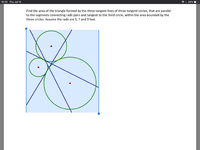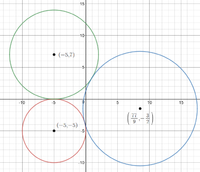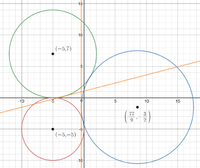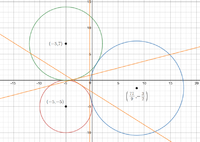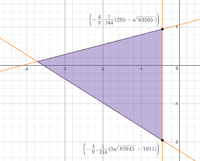I unfortunately made an error in my placement of the largest circle, so I am going to work the problem again, from start to finish, using the correct location.
Let's begin by placing the two smaller circles in the plane as follows:
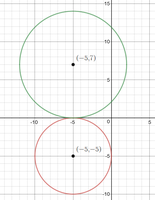
Now, the center of the largest circle must satisfy the nonlinear system:
[MATH](x+5)^2+(y+5)^2=14^2[/MATH]
[MATH](x+5)^2+(y-7)^2=16^2[/MATH]
Solving this system, and taking the solution which places the largest circle to the right of the others, we obtain:
[MATH](x,y)=\left(\frac{7}{2}\sqrt{15}-5,-\frac{3}{2}\right)[/MATH]
And so we now place the largest circle in the plane:
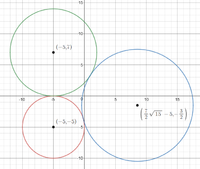
The vertical tangent line (tangent to the largest circle) will be:
[MATH]x=\frac{7}{2}\sqrt{15}-14[/MATH]
The line tangent to the circle of radius 7 will have a slope of:
[MATH]m=\frac{-\dfrac{3}{2}+5}{\dfrac{7}{2}\sqrt{15}-5-(-5)}=\frac{1}{\sqrt{15}}[/MATH]
The tangent point is obtained through:
[MATH]\frac{7-y_1}{-5-x_1}=-\sqrt{15}[/MATH]
[MATH](x_1+5)^2+(y_1-7)^2=7^2[/MATH]
This gives us the tangent point:
[MATH]\left(x_1,y_1\right)=\left(-\frac{13}{4},\frac{7}{4}(4-\sqrt{15})\right)[/MATH]
And so this tangent line has the equation:
[MATH]y=\frac{1}{\sqrt{15}}x+7-\frac{23}{\sqrt{15}}[/MATH]
For the line tangent to the smallest circle, it's slope is:
[MATH]m=\frac{-\dfrac{3}{2}-7}{\dfrac{7}{2}\sqrt{15}-5-(-5)}=-\frac{17}{7\sqrt{15}}[/MATH]
The tangent point is obtained through:
[MATH]\frac{-5-y_1}{-5-x_1}=\frac{7\sqrt{15}}{17}[/MATH]
[MATH](x_1+5)^2+(y_1+5)^2=5^2[/MATH]
This gives us the tangent point:
[MATH]\left(x_1,y_1\right)=\left(-\frac{75}{32},\frac{35}{32}\sqrt{15}-5\right)[/MATH]
And so this tangent line has the equation:
[MATH]y=-\frac{17}{7\sqrt{15}}x+\frac{817}{224}\sqrt{\frac{3}{5}}-5[/MATH]
Here is a plot including the three tangent lines:
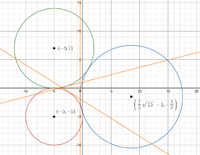
We then find that the length of the vertical side of the triangle whose area we are finding is:
[MATH]\left(\frac{21}{2}-\frac{37}{\sqrt{15}}\right)-\left(\frac{10067}{224\sqrt{15}}-\frac{27}{2}\right)=\frac{1}{672}\left(16128-3671\sqrt{15}\right)[/MATH]
The area of the triangle whose vertices are at the centers of the circles is:
[MATH]A_V=\frac{1}{2}(7-(-5))\left(\frac{7}{2}\sqrt{15}-5-(-5)\right)=21\sqrt{15}[/MATH]
Also:
[MATH]A_V=k(12)^2\implies k=\frac{7\sqrt{15}}{48}[/MATH]
Hence, the area we want is:
[MATH]A=\frac{7\sqrt{15}}{48}\left(\frac{1}{672}\left(16128-3671\sqrt{15}\right)\right)^2=\frac{154085333\sqrt{15}-592058880}{1032192}\approx4.56412[/MATH]
I sure hope I didn't make any other errors!!


